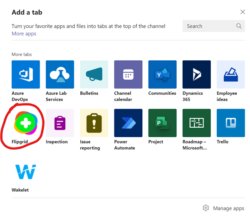Generating constructive peer feedback in breakout rooms
This article suggests a method for improving student engagement and criticality through generating paired peer feedback in breakout rooms.
What did you do? Why did you do it?
This activity made use of Flipgrid, a video recording software which is an office 365 app and available as an optional tab on Teams.

Prior to the live session, I asked students to create a short 2 minute individual Flipgrid video on their understanding and research ideas for one of the course topics. In the live session I paired students together, allocating each pair two Flipgrid videos to watch, and asked them to prepare oral feedback for both of the videos. For this task, I put each pair in their own breakout room. After the designated time I brought all students back to the main room and instructed each to individually give the feedback they had generated in pairs in video form by selecting the camera feature in the comments box.

I chose to use this method for peer feedback for several reasons:
- Previous online peer feedback tasks where students have been asked to respond to the content of posts or videos could be considered less successful as comments focused heavily on the positives, with negatives being mostly related to non-academic issues such as sound quality.
- By asking students to work on feedback in pairs, I hoped to reduce the fear of being critical of others as it would not be clear to their peers exactly who produced each comment. Although just one student would record the video feedback, the content of the feedback would have been produced by two.
- Putting the pairs in breakout rooms allows for privacy and encourages more engagement in the task as there is nowhere to hide. It could also be considered less intimidating to work in such a small group.
- The task allows for student centred learning as the students are responsible for the feedback to their peers.
- Asking for feedback to be delivered through Flipgrid rather than through writing is less time consuming.
- Finally, asking pairs to generate feedback can help to produce a more in-depth analysis (two heads are better than one!).
What was the impact of your practice and how have you evaluated it?
I noticed an immediate impact upon visiting each breakout room. Previously some students were hesitant to speak up during live sessions but in the breakout rooms they were fully engaged in the task with their partners, to such an extent that I barely needed to ‘help out’ with discussions compared to before. Additionally, when listening to the discussions, I could hear a significant amount of critical thinking, yet this was something that many had not demonstrated in previous live sessions. The follow up feedback videos also demonstrated these unearthed skills as well as a more confident and sophisticated monologues than previous attempts. In later live sessions I noted a significant improvement in the quantity and quality of student contributions, without the need to ask for volunteers. Students also began asking me questions in the live sessions whereas before they had relied on Teams chat messages.
How could others benefit from this example?
This method could be used in any online peer feedback situation, as a means to increase student engagement and student-centred learning.
Author
Laura Dyer, l.v.dyer@leeds.ac.uk, Language Centre
Do you have an example of your practice to share?
If you are interested in submitting an article to the TIPS Blog find out how to submit here, or contact the TIPS Editors at academicdev@leeds.ac.uk.
